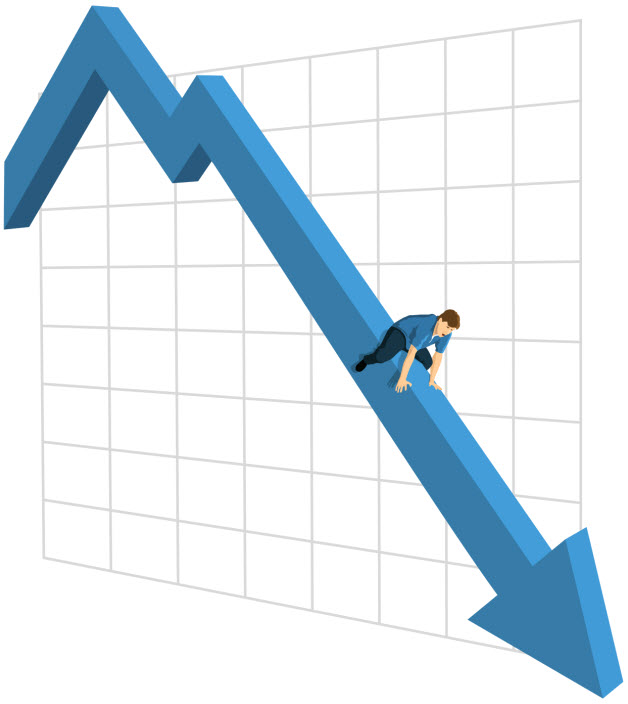Timing & trends
Below is our updated wave chart of the Dow Jones Industrial Average. We get the sense that if we don’t get
the “bounce” higher soon, this market can fall hard i.e. major capitulation from the newly anointed bulls. By our
count we are entering the most powerful leg of the down wave. We are assuming the bear market rally to 13,339 on
May 1st is done! [Labeled 2 of 3] We want to remain long-term short equities and most risk asset markets as the
global macro is playing out as we anticipated.

Subscribe to Black Swan’s Free Currency Currents HERE (subscription lower right side)
via The Big Picture
1. Societies, Economies and Markets Move in Long Cycles: Investors have to understand long cycles — and that half of them are not good:
Think about the post WW2 era — GI Bill sent millions of returning soldiers to school, the building out of suburbia, rise of the car culture, construction interstate highway system, civilian air service, broad electronics development — its no coincidence that 1946-66 was a long term secular bull market (good) for stocks. This investors paradise was followed by an ugly period: 1966-82 had VietNam, Watergate, Oil Embargo, Inflation, etc. In 1966 the Dow was 1000 and in 1982 it was still 1000 — 16 years, no gains (not good). The next good run was the 1982-2000 period that saw the rise of the PC, chips, software, internet, mobile, networks, storage etc. Another golden era for investing. (good). Do I need to explain 2000-2012 and counting? (not good).
If you don’t understand these cycles, you will not be a successful investor.
2. Long term doesn’t matter if you are in the middle of a bear market: Like we are today. I cannot tell you when it will end, but history suggests sometime before the next 5 years are over.
During these secular bear markets, your job is to reduce risk, carry more cash and bonds, and wait for better times. Tactical adjustments are what get you through these periods — not sitting fully invested in equities and getting shellacked. (See number 1 above)
3. Ignore pretty charts in Marketing Materials: Whatever you are shown in glossy brochures is nonsense sales bullshit. Never make any decision based on the old couple walking down the path, or a picture of boats. Its junk advertising — and amazingly, it is an effective way to capture the suckers.
Howard called it “bullshit” in the audio — and it still ensnared him. That’s how effective it is.
4. Your advisor should help you to Educate you.. More than just managing your money, your advisor should help you understand what is occurring financially in the world.
They should have a working knowledge about valuation, trends, economy, sentiment and market internals. They should be able to tell you what is working and what is not and why. A good advisor can contextualize the headlines, not merely read them to you. They should be able to answer all of your questions, and when they cannot, they should honestly tell you so — and then go find the answer for you.
5. Buy & Hold is for Secular Bull, Not Bear Markets. Buy & Hold is folly during secular bear markets like 1966-82 or 2000-to-today. Simply stated, it is against human nature and therefor will not work. People get tired, annoyed and angry. Human nature is such that no one wants to lose money for 15 years. This ultimately leads to frustration and bad decision making.
Secular bear markets like the one we are in right now is not when you want to work with a buy & hold advisor (like Howard’s).
6. Caution When Too Much Wealth is Tied Up in One Stock: You would think that this lesson would have been learned after Worldcom, Enron, Lucent, Lehman Brothers and soon Facebook, but apparently not.
Anyone with a substantial amount of their personal net worth tied up in a single company needs to diversify that holding as soon as possible. We can argue if 40% or 75% is too much, but the short answer is if you are even debating it, you need to diversify your risk away from that one holding. PERIOD.
7. Build a Bond Ladder 7-15 Years Out: Ladders are bond portfolios of differing maturities (rungs) designed to capitalize on falling or rising yields. Higher yields means you build a longer ladder (15-20 years); low rates like today means you keep it shorter duration. HNW investors should have a substantial income stream from a diversified portfolio of Treasuries, A-rated Munis and investment-grade Corporates. With rates this low, the bond ladder should be no longer than 7 years.
8. Rising Bond Prices = Lock in Yield: This has been a 30 year bull market for bonds. Anyone who is HNW should have been advised to ladder a portfolio decades ago, up to as recently as 2005-06.
You can still build a bond ladder today — just don’t expect too much in way of returns. Expect higher or more normalized rates in the future.
9. Collars (XM Sirius): There are occasions when great concentrations of stock wealth cannot be sold immediately. These are what the costless stock collar was invented for. It uses stock options to lock in a range of prices, and dramatically reduce the downside risk.
Let’s say hypothetically, if you owned 400 million worth of Apple, and were getting nervous. They could sell the January 2014 600 calls for $92, use the proceeds to buy January 2014 535 puts for $89. Upside is limited to $600, but the downside is capped at $535.
This is what should have been done for Howard back when SIRI stock had some value.
10. Covered Calls: Lacking a collar, the SIRI stock is now under $2. Depending on the stock holding, income can be generated writing covered calls — selling out of the money options to pick up revenue. This is only done if the writer is happy to sell and does not believe the stock has much upside.
via Barry Ritholtz excellent site: The Big Picture
When it comes to the future, suddenly torn by economic uncertainty driven by a plunging stock market and a tanking economy, the talking heads and the sellside brigade have opined:more QE, preferably in the form of asset purchases. After all it was none other than Goldmanearlier today who said that “our confidence that the FOMC will ease policy once more at the June 19-20 meeting has also grown… Our baseline remains that Fed officials will purchase a mixture of mortgages and long-term Treasuries, financed via balance sheet expansion… If they decide to extend their balance sheet, they could add excess bank reserves or “sterilize” the reserve impact via reverse repos and/or term deposits.” In other words….
….read the entire article HERE

An intensifying financial crisis in Spain or elsewhere in Europe has the potential to drive American stocks into a bear market, Goldman Sachs Group Inc. (GS)’s chief U.S. equity strategist said.
Kostin said investors face three upcoming macro events that may add uncertainty: the second round of Greek elections on June 17, the Federal Open Market Committee’s June meeting and the U.S. Supreme Court’s ruling on health-care reform.
….read more HERE
Bob Hoye in this Money Talks article, was again very clear that we are now at another critical point in the markets and that its now time to either save your capital and get out of the way, or make some money (by shorting -ED)


















